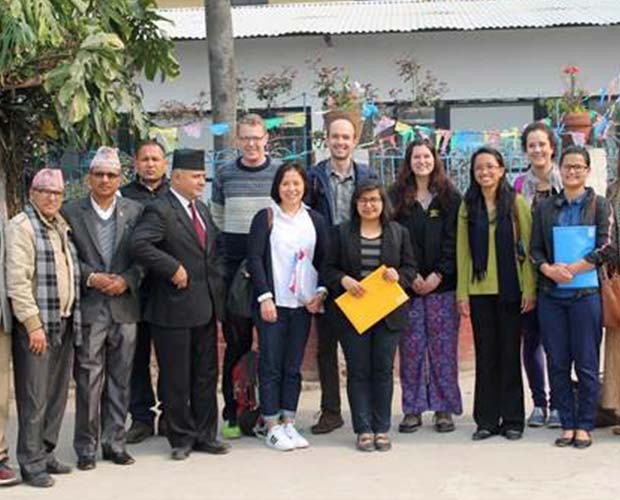Bush School Students Study Impacts of Natural Disasters and Conflict in Nepal
As part of a capstone research project under the guidance of Dr. Ren Mu, associate professor at the Bush School, on behalf of the Center on Conflict and Development at Texas A&M University and the United States Agency for International Development (USAID). This is the first empirical study examining how the history of conflict impacts natural disaster resilience.
The original inspiration for the project was the result of an internship of a Bush School student, Morten Wendelbo, at the European Institute for Asian Studies in Brussels, Belgium. As a result of the internship, Wendelbo led a multi-agency project researching the preparedness response to the 2015 earthquakes in Nepal. When he returned from that experience, he approached Dr. Mu about potentially researching more about the disaster response of Nepal for a capstone research project.
“Nepal had an earthquake last year in April that registered 7.82 on the Richter scale, and more than 8,000 people died,” said Mu. “Not too long ago, Nepal had ten years of armed conflict in the country; so we just linked these two variables—natural disaster resilience and the conflict history of Nepal. Also we were reading reports on Nepal, and we realized a missing part was the impact on school-aged children. I began to be concerned that if children dropped out of school because of the earthquake, then the earthquake would have a very long impact on the development of the country.”
The primary purpose of the trip to Nepal was to gather data on school enrollment and attendance after the earthquake that struck Nepal in 2015. The research team interviewed more than 300 children at twelve different schools and, by asking information on their siblings, gained data on more than 800 children ages five to eighteen that had been affected by the 2015 earthquakes. By combining this primary data with data from the 2011 Nepal Living Standard Survey, the team’s preliminary results show there is a small negative impact on educational outcomes as a result of the earthquake.
“Damage to schools is only one factor that could impact education attainment in Nepal,” said Brittany Hardin Tanguay, a member of the capstone team. “Other concerns the kids voiced included fear of going to school, discomfort in temporary classrooms, and the need to work at home. On top of everything else, a difficult journey of walking more than an hour each way, which many children have to face, is a likely deterrent to school attendance.”
The trip was especially meaningful for one member of the capstone, Sanmita Nepal, who came to the Bush School as an international student from Nepal.
“Coming to the Bush School, I never realized I would get to do a capstone based on my own country,” said Sanmita. “However, I always knew I wanted to make a difference back home. Later this semester, we will present the findings of our research to USAID, which hopefully will raise awareness and result in better policy.”
The research on the impact of school attendance and enrollment was only one part of the semester-long capstone research project. Prior to the trip to Nepal, the team also collected data in order to determine how past conflict experience impacted natural disaster outcomes. By partnering with a faculty member from the College of Geosciences at Texas A&M University, the team gained a better measure of the impact level of the 2015 earthquake. After combining data on the conflict history of Nepal and the level of earthquake damage within the country, the team found a relationship between the past level of conflict experienced by an area and an area’s ability to respond to natural disasters.
“We found that past conflict has a negative impact on disaster resilience to earthquake damage,” said Mu. “Considering the conflict ended a decade ago, in 2006, you still see the impact. The negative impact is more pronounced in places with more severe earthquake damage.”
While in Nepal, the Bush School team presented their initial findings on the relationship between conflict and natural disaster response to the USAID office in Katmandu, where the work was well received by USAID officials.
“I hope this research will help international aid organizations think about the long-term impact of conflicts,” said Mu. “Conflict history may manifest itself in ways that we may not have thought about before, like earthquake resilience. The implication is that we should pay attention to conflict history; and when aid organizations do post-disaster work, they should have that in mind. I hope that people pay more attention to primary and secondary education in post-disaster areas.”
While researching the impacts of past conflicts and earthquakes, the research team came away with more than just data. Members of the team said they were impacted by the buoyant spirits of the schoolchildren they encountered there.
“It was very touching to see children there,” said Mu. “Their schools were destroyed, and they are now in temporary tent huts. But children are children. They laugh, they were curious, they would make faces—it was very cute. I think all of us enjoyed the interactions with the children. I think it’s the hope of the country.”
Like Mu, Brittany Tanguay also shared her belief that the children’s joy in the face of adversity signals the country may have better days ahead.
“Despite their circumstances, the kids seem to be happy—at every school we went to, we were greeted by resounding cries of ‘namaste,’ laughter, and pleas to join in their fun and games,” said Tanguay. “Nepal is a small country that has suffered more than its share of struggles in the past few decades. However, if the spirit of its children is any indication, there is hope in this time of hardship.”

